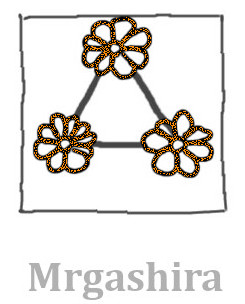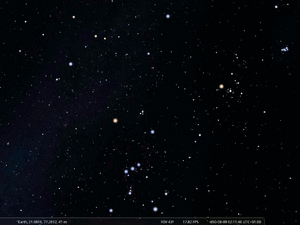Mrigashira: Difference between revisions
No edit summary |
|||
| (8 intermediate revisions by the same user not shown) | |||
| Line 1: | Line 1: | ||
{{DISPLAYTITLE:Mṛgaśira (मृगशिर)}} |
|||
| ⚫ | |||
[[File:Mrgashira nakshatras in Temple draw+lbl 4ase.jpg|thumb|Mrgashira in Tirupperunthurai (Athmanathaswamy temple) near Aranthangi, India, 10th century CE. (SMH 2025).]] |
|||
[[File:觜宿(仏像図彙).png|thumb|『仏像図彙』による觜宿(Mṛgaśīrṣa)]] |
|||
[[File:5+ Mrigashira+Ardra stellarium.gif|thumb|The animated GIF shows thepositions of the Nakshatras on the Stellarium map. ]] |
|||
| ⚫ | |||
| ⚫ | |||
==Etymology and History== |
==Etymology and History== |
||
'''Name Variants''' |
|||
What does the term mean, does it always have the same meaning - was it changed over time. |
|||
*Mrigashira, |
|||
*Mṛgaśira, |
|||
*Somya, |
|||
*Āgrahāyaṇī |
|||
===Origin of Constellation=== |
===Origin of Constellation=== |
||
Mṛgaśira, Somya means "the deer's head"; it is a composite of two Sanskrit words, mṛga (मृग), deer, and śira (शिर), top of the head. The depiction in temples is here mapped to the three stars in Orion, but it may also be possible that The Deer as a constelllation had originally been larger and the three stars just formed a pattern on the top of its head (like they indicate the head of the Greek hero who is drawn in a larger star pattern). |
|||
Also known as āgrahāyaṇī. |
|||
The asterism is described in a Treatise on the Sun (Surya Siddhānta) that dates between the 4th and 9th century CE, but also (with all other nakshatras) in the Athavaveda from the early first millennium BCE. Yet, images are preserved in temples only from the past millennium. |
|||
===Transfer and Transformation of the Constellation=== |
===Transfer and Transformation of the Constellation=== |
||
<gallery> |
|||
File:Mrgashira nakshatras in Temple draw+lbl 4ase.jpg|Mrgashira 10th century CE |
|||
File:Nakshatra temple magDraw lbl.jpg|Display of all 28th nakshatras in silver arch with candles in Tirupperunthurai (Athmanathaswamy temple) near Aranthangi, India, 10th century CE. (SMH 2025). |
|||
File:Nakshatras in Temple draw+lbl 4ase.jpg|Display of all 28th nakshatras in a door frame in Tirupperunthurai (Athmanathaswamy temple) near Aranthangi, India, 10th century CE. (SMH 2025). |
|||
| ⚫ | |||
File:觜宿(仏像図彙).png|Mrgashira, Chinese |
|||
File:Male red deer (Cervus elaphus), Munich, Germany - 20060530.jpg|male red deer |
|||
File:5 Mrigashira draw.png|Mrgashira as reconstructed by Jones (1720) |
|||
</gallery> |
|||
==Mythology== |
==Mythology== |
||
| Line 11: | Line 33: | ||
==Weblinks== |
==Weblinks== |
||
* |
* |
||
==References== |
==References == |
||
*[[References]] (general) |
*[[References]] (general) |
||
[[Category:Indian]] |
|||
[[Category:Indian]] [[Category:Asterism]] [[Category:Constellation]][[Category:Eurasia]][[Category:South Asian]] |
|||
[[Category:Asterism]] |
|||
[[Category:Constellation]] |
|||
[[Category:Eurasia]] |
|||
[[Category:South Asian]] |
|||
Latest revision as of 16:32, 30 October 2025
Mṛgaśira (मृगशिर) is an Indian name, used by the Indian Vedic tradition. Most of these names are roughly 3000 years old. They pre-date Hinduism but were taken over by it. The asterism has three stars and, thus, refers to the group φ1,2 and λ Orionis.
Etymology and History
Name Variants
- Mrigashira,
- Mṛgaśira,
- Somya,
- Āgrahāyaṇī
Origin of Constellation
Mṛgaśira, Somya means "the deer's head"; it is a composite of two Sanskrit words, mṛga (मृग), deer, and śira (शिर), top of the head. The depiction in temples is here mapped to the three stars in Orion, but it may also be possible that The Deer as a constelllation had originally been larger and the three stars just formed a pattern on the top of its head (like they indicate the head of the Greek hero who is drawn in a larger star pattern).
Also known as āgrahāyaṇī.
The asterism is described in a Treatise on the Sun (Surya Siddhānta) that dates between the 4th and 9th century CE, but also (with all other nakshatras) in the Athavaveda from the early first millennium BCE. Yet, images are preserved in temples only from the past millennium.
Transfer and Transformation of the Constellation
Mythology
mnemonic tales and cultural significance
Weblinks
References
- References (general)












